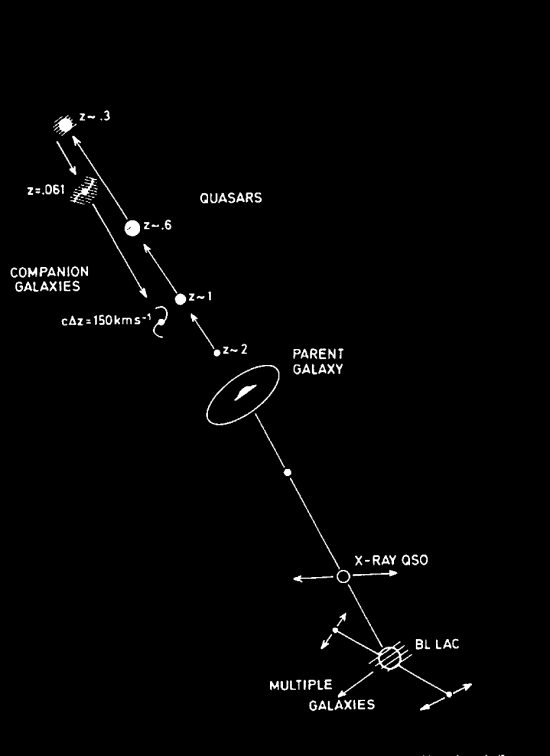
November 24, 2020
Quasars are not gravitational entities, they are electrical.
According to a recent press release, Lizelke Klindt, a PhD researcher in Durham University’s Centre for Extragalactic Astronomy, said:
“How quasars develop has been the cause of significant uncertainty. What our results suggest is that quasars undergo a brief transition phase, changing colour from red to blue, when they emerge from the deep shroud of dust and gas surrounding them.
That “emergence” is said to be caused by a supermassive black hole at the center of a quasar “ejecting great quantities of matter,” driving away material surrounding it. Astronomer Halton Arp proposed an alternative theory, that active galaxies—galaxies with powerfully radiating nuclei—eject “daughter” objects in pairs in opposite directions. Initially, those blobs of material are without mass and possess high redshifts: z = 2, or greater. As other mass in the Universe “recognizes” the newly ejected quasar, its mass increases in accord with Ernst Mach’s theory of inertia. The new quasar’s velocity of ejection decreases in accord with conservation of momentum.
Arp’s theory proposes that, with each increase in mass, light energy increases: the same transition in an atom or particle produces a photon at a higher frequency, that is, shifted toward the blue end of the spectrum. As a quasar ages, its light becomes less redshifted. It approaches the redshift of the parent galaxy.
As Electric Universe advocate, Mel Acheson noted:
“Objects with intrinsic z’s of .06 tend to be galaxies; those with z’s of 1.96 tend to be quasars. This sequence implies an evolution from ejected quasar to compact cluster to companion galaxy as the matter ages. It groups deep sky objects into families and genealogies of families.”
In an Electric Universe, quasars and black holes are not related. Primarily because black holes do not exist. Electric star theory suggests that no concentrated gravity from hypothetical objects is necessary. Classical electromagnetism does not depend on the supernatural physics of black holes. Plasma discharge events are commonly known to generate high-energy light. The more electric charge, the higher the frequency of light will be emitted. Supply enough power and X-rays are generated.
X-rays and gamma rays in space are not created in gravity fields. Laboratory experiments most easily produce them by accelerating charged particles through an electric field. No gigantic masses compressed into tiny volumes are necessary, and they are easily generated with the proper models. Moving away from gravity toward electricity as the dominant force in the Universe will resolve many of those issues.
Stephen Smith
The Thunderbolts Picture of the Day is generously supported by the Mainwaring Archive Foundation.












